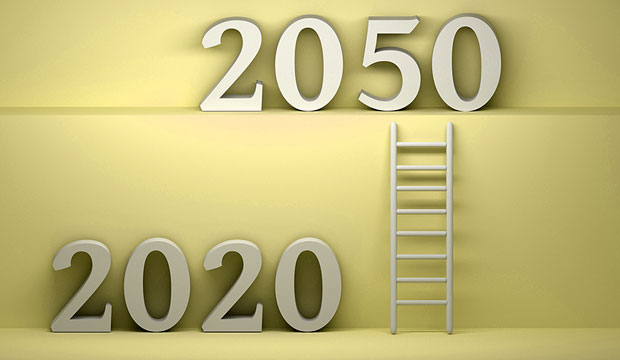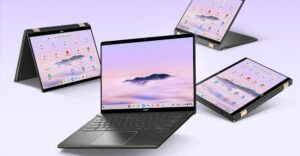Qualcomm recently took an in-depth look back at the history of the mobile phone, which it was mostly responsible for creating. This turned out to be a personal retrospect because my family owned an electronics company in the 1960s, which was when I used my first mobile phone in my father’s Studebaker Avanti.
At the time, I thought it was the most amazing thing to be able to make a call from a car. What was funny is that phone had a dial and buttons, which mostly didn’t seem to do anything, and it worked more like a radio on a boat or plane than an actual phone. But it was cool.
As we advance 50 years to the present, our smartphones do more things than our PCs because they are more portable, more likely to be with us, and handle telephony.
Cisco last week released its desktop phone replacement, the Webex Desk Hub. While this device initially only merges your desktop phone and smartphone, it could quickly evolve to replace your PC as well.
Since we’re approaching the end of 2020, let’s speculate a bit about how the smartphone and the PC will likely evolve over the next three decades and build up to what that means for personal communications technology in 2050.
We’ll close with my product of the week, the aforementioned Webex Desk Hub, which is arguably the most evolutionary innovation to the desk phone since its invention.
The song “In the Year 2525” is suddenly playing over and over in my head.
2030
Ten years from now, we should be at critical mass with autonomous cars. Digital assistants will finally be living up to their potential, and renewable energy should be the default, but we’ll still be living through the results of climate change.
We’ll still have wired networks (recall how long the fax machine hung in there), but the new development should be wireless. Anticipated cyberattacks will have already crippled several governments, transportation systems, and companies, so a focused and funded international law enforcement group chasing cybercriminals is likely.
We’ll be well into robotics and should have some advanced man-machine interfaces, likely initially in the military. However, it is still too soon for technology to be embedded into civilians outside prosthetics to address severe injuries.
This future suggests that at least the cutting-edge and high-end smartphones will be head-mounted and wearable, and less-expensive solutions will have connected head-mounted displays. These displays will allow you to instantly video conference and use photorealistic avatars to look like you are in the virtual space. Depending on how many more pandemics we have by that time, offices as we knew them are at risk of becoming obsolete, making it at least likely that your office will be wherever you are.
These head-mounted phones will not only have biometric interfaces to allow third parties to monitor your health and provide timely help, but to assure you are who you say you are and to advise you on decisions to provide the most successful outcomes.
Much of the power of these now-worn devices will be in the cloud, and most of how we interface with them will be using voice. Standard capabilities will include instant translation and alerting of people nearby who may be sick or put you at risk.
2040
This decade is getting close to when many think we’ll be approaching singularity and the merger of humans and technology. We’ll have issues with people who have aggressively embraced this merger of man and machine, conflicting with purists who believe in a blend of conflict with their religion.
Those who have embedded technology will have significant advantages both physically and mentally and have significant problems with identity and ethics. Misuse of this capability will likely be common as law enforcement, and governments struggle with balancing innovation and social unrest and discrimination. It is feasible that much like we have discrimination based on race now, we’ll have discrimination based on technology/human blends then.
We should have advanced personal robotics, advanced autonomous drones, cars, and autonomous military and security systems which can be expected to go rogue from time to time — often due to being hacked. We should see the beginning of an embedded communication system, most likely to appear in the military, intelligence, and some advanced law enforcement units. We probably will have a lot of complicated laws to enforce surrounding the use of these technologies.
By this time, PCs are entirely virtual, voice communications are thoroughly blended with all other communications types, and AI is filtered to optimize your time. Many of the conversations you have, and people have with you, will be with AIs emulating people and then summarizing what was discussed. These AIs will be fully trained to emulate who you are and can do many, if not most, of the repetitive tasks you currently perform.
2050
This decade takes us to where many of us believe the singularity will have primarily occurred. We’ll still have pure humans that live in defined regions or off-planet fighting the change. Still, most people will be connected to their computing resources surgically and call on those services mentally to enhance performance.
Digital immortality becomes far more common — though it has been available to the rich for some time at this point — and your digital assistant can morph into friends and family (even deceased family) that you can interface with throughout your life. By this time, people who want to live in a virtual world can, and the need for human workers will be vastly reduced given that robots and AIs will be fully able to take your ideas and translate them into action.
Your ability to multitask will be massively enhanced. A service will primarily regulate your body, and your mental attitude will be remotely regulated. This outcome will create significant problems concerning the determination of what is human and what is a robot, given there will be a lot of variation in the depth of the blend between the two concepts. You generally won’t tell or care if you are talking to a real person or an AI, and much of your interaction will now occur with digital AI proxies.
Here the smartphone no longer exists because communication is inherent with your embedded technology solution. This outcome will significantly broaden the divide between those that can afford and accept these technological changes and those that don’t. I expect there will be many conflicts that will resolve poorly for pure humans in this decade. In short, in the 2050s, you become the smartphone.
Wrapping Up
While I’m providing a very focused outlook, I am leaving out a few things:
– The obsolescence of transportation: because if you can go anyplace virtually and feel like you are there, do you need to travel?
– Changes to the nuclear family: because I expect many will choose a virtual mate over a human, given they can be custom-built for you. Will you want to raise a child or have a permanent virtual child — or an intelligent virtual or robotic pet that is your perfect match?
I expect that sometime in the 2030s, PCs and phones will merge if they hadn’t already. In the 2040s, people and personal technology will merge as humans and robotics evolve into hybrids of both. We’ll have many political, social, and religious hurdles to overcome — some of which are likely to result in war both inside of and between countries before reaching the 2060s.
This outcome could be a utopia — or hell on Earth — depending on how well we manage these changes, and the only sure thing is we aren’t anywhere near ready for them.

The Cisco Webex Desk Hub
I started working for IBM’s telephony division and eventually made it over to competitive analysis working on desktop hardware. Last week, when Cisco showcased its Webex Desktop Hub, I got excited because it embodies many of the things we were working on back in the 1980s that never made it to market: embracing the blends of office and personal smartphones, voice and video communications; and the full blend of texting, social media, and more traditional communications methods. This, indeed is a future-facing offering.
Physically it is a wireless charging dock, a dock for your connected headphones (which Cisco also announced), a display that enhances the one on your smartphone, and an interface for video communications when connected with the new Cisco camera.

It will also auto-configure your workspace if your company is consistent with most others — and eliminates permanent office spaces in favor of shared hoteling resources. You dock your smartphone, and the space will configure itself to you depending on how smart the office is. Though I think this will create an increased risk that you’ll leave your phone behind when you leave your office, I expect it to be addressed with a future accessory or app.
Because the Cisco Webex Hub is a big step into the future that many of us foresaw a couple of decades ago and a bridge to our post-COVID-19 world, it is my product of the week.





















































